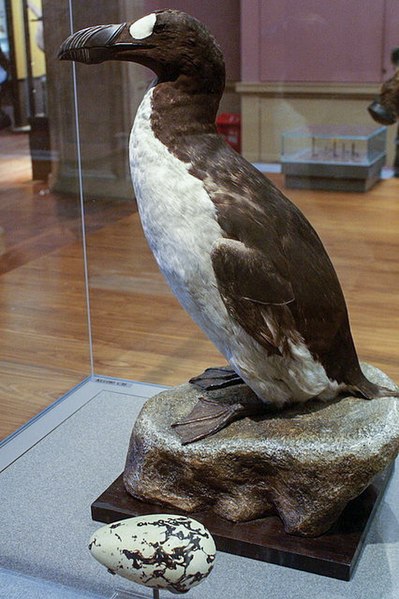Hello ladies and gents this is the Viking telling you that today we are talking about
THE GREAT AUK
The Little Ice Age may have reduced the population of the great auk by exposing more of their breeding islands to predation by polar bears, but massive exploitation by humans for their down drastically reduced the population, with recent evidence indicating the latter alone is likely the primary driver of its extinction.
By the mid-sixteenth century, the nesting colonies along the European side of the Atlantic were nearly all eliminated by humans killing this bird for its down, which was used to make pillows. In 1553, the great auk received its first official protection, and in 1794 Great Britain banned the killing of this species for its feathers.
In St. John's, those violating a 1775 law banning hunting the great auk for its feathers or eggs were publicly flogged, though hunting for use as fishing bait was still permitted.[46] On the North American side, eider down initially was preferred, but once the eiders were nearly driven to extinction in the 1770s, down collectors switched to the great auk at the same time that hunting for food, fishing bait, and oil decreased.
The great auk had disappeared from Funk Island by 1800. An account by Aaron Thomas of HMS Boston from 1794 described how the bird had been slaughtered systematically until then:
If you come for their Feathers you do not give yourself the trouble of killing them, but lay hold of one and pluck the best of the Feathers. You then turn the poor Penguin adrift, with his skin half naked and torn off, to perish at his leasure. This is not a very humane method but it is the common practize.
While you abide on this island you are in the constant practice of horrid cruelties for you not only skin them Alive, but you burn them Alive also to cook their Bodies with. You take a kettle with you into which you put a Penguin or two, you kindle a fire under it, and this fire is absolutely made of the unfortunate Penguins themselves. Their bodies being oily soon produce a Flame; there is no wood on the island
With its increasing rarity, specimens of the great auk and its eggs became collectible and highly prized by rich Europeans, and the loss of a large number of its eggs to collection contributed to the demise of the species. Eggers, individuals who visited the nesting sites of the great auk to collect their eggs, quickly realized that the birds did not all lay their eggs on the same day, so they could make return visits to the same breeding colony. Eggers only collected the eggs without embryos and typically, discarded the eggs with embryos growing inside of them.
On the islet of Stac an Armin, St. Kilda, Scotland, in July 1840, the last great auk seen in Britain was caught and killed. Three men from St. Kilda caught a single "garefowl", noticing its little wings and the large white spot on its head. They tied it up and kept it alive for three days, until a large storm arose. Believing that the bird was a witch and was causing the storm, they then killed it by beating it with a stick.
The last colony of great auks lived on Geirfuglasker (the "Great Auk Rock") off Iceland. This islet was a volcanic rock surrounded by cliffs that made it inaccessible to humans, but in 1830, the islet submerged after a volcanic eruption, and the birds moved to the nearby island of Eldey, which was accessible from a single side.
When the colony initially was discovered in 1835, nearly fifty birds were present. Museums, desiring the skins of the great auk for preservation and display, quickly began collecting birds from the colony. The last pair, found incubating an egg, was killed there on 3 June 1844, on request from a merchant who wanted specimens, with Jón Brandsson and Sigurður Ísleifsson strangling the adults and Ketill Ketilsson smashing the egg with his boot.
Great Auk specialist John Wolley interviewed the two men who killed the last birds, and Sigurður described the act as follows:
The rocks were covered with blackbirds and there were the Geirfugles ... They walked slowly. Jón Brandsson crept up with his arms open. The bird that Jón got went into a corner but was going to the edge of the cliff. It walked like a man ... but moved its feet quickly. caught it close to the edge – a precipice many fathoms deep. Its wings lay close to the sides – not hanging out. I took him by the neck and he flapped his wings. He made no cry. I strangled him.
A later claim of a live individual sighted in 1852 on the Grand Banks of Newfoundland has been accepted by the International Union for Conservation of Nature and Natural Resources (IUCN).
There is an ongoing discussion on the internet about the possibilities for recreating the Great Auk using its DNA from specimens collected. This possibility is controversial.
And as always have a chilled day from the Viking

Comments
Post a Comment